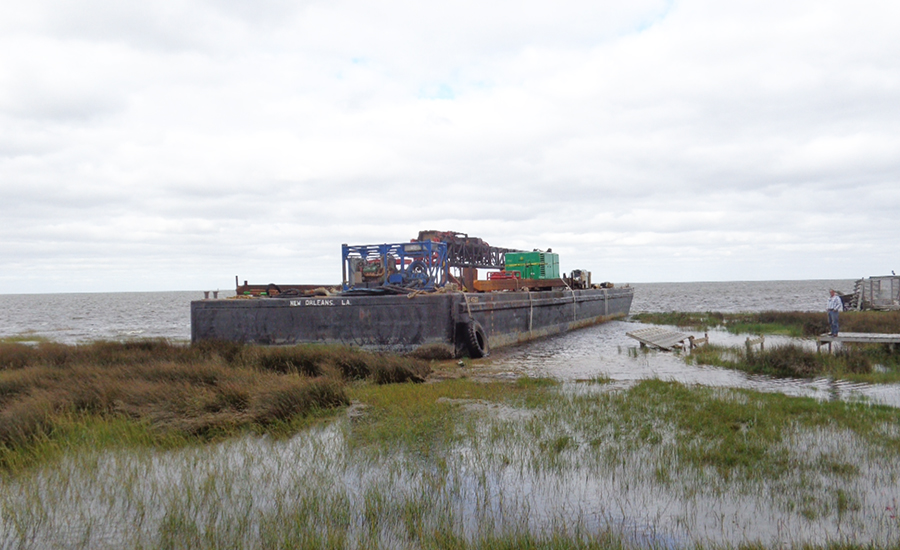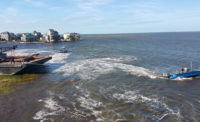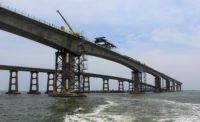Battening down a major, on-the-water construction project in the face of an approaching hurricane is a high stakes game. The odds of a strike are almost never even close to sure at the time when preparations must be made, but the penalty for delayed decisions, or a bad bet, can be extreme.
And even when the most conservative approach is used…well, we’re talking about hurricanes. Ultimately, they will do what they will do.
PCL Civil Constructors was faced with such a dilemma as Hurricane Matthew cleared Haiti and turned its trajectory for a roll up the southeast U.S. coast. PCL’s fleet of equipment floating around and servicing the jobsite of the new $216 million Herbert C. Bonner Bridge on the North Carolina’s Outer Banks was potentially at risk, even though track models at the time had the storm going all over the place, including taking a sharp right toward France or looping south again through the Bahamas.
Nevertheless, contractors on such exposed projects must abide by strict guidelines for demobilization when the chances of tropical storm-force winds hitting the site within several days arise.
With Matthew still ravaging the Caribbean on Oct. 4, PCL’s project team began implementing its Hurricane Preparedness Plan, with an eye toward having the project site fully secured and evacuated within two days, “so that our employees have adequate time to take care of their families in preparation for the storm,” says PCL Area Manager Jim Schneiderman.
Pablo Hernandez, resident engineer for the North Carolina Dept. of Transportation’s Division 1, reports that from all indications, PCL did “a very good job of securing the site for the storm. They lashed and tied down what could blow away, lowered crane booms, and stacked and pinned crane mats.”
He adds that most of the marine equipment deployed for the construction work was taken to a designated mooring site about 8 miles southwest of Oregon Inlet. Noted on nautical charts as the Pamlico Sound Mooring Location, the environmentally permitted site provides four large mooring anchors for securing construction vessels during routine operations, as well as when hurricanes and other major storms come calling on the Outer Banks.
Hernandez adds that the only major items left at the bridge site were the two big crane barges, which had been anchored at a predetermined hole at the south end of the project site.
All that was left to do was wait, even as Matthew’s Southeast coast-straddling track failed to diminish the uncertainty.
“We were prepared,” Hernandez says.
Though Matthew’s center ultimately passed just to the south of Cape Hatteras during the weekend of Oct. 8-9, the storm’s 80-mph wind gusts played havoc with the normally placid waters of Pamlico Sound. At some point—no one knows exactly when or how—two 140-ft-long barges were snatched away by the elements. They were discovered the following day, having grounding themselves almost 30 miles away at separate locations near the village of Avon, located on the back, or sound-side of Hatteras Island.
“They’d been tied up to other barges, which were directly anchored at the mooring location,” Hernandez says, speculating that a combination of wave action, wind, and storm surge—and maybe lashing fatigue—abetted the vessels’ escape.
Hernandez describes the two fugitive barges as 140 ft long, 45 ft wide, and 9 ft tall, with an estimated weight (with load) of 340-360 tons. They are deep draft barges that would draw 1 to 1.5 ft empty, 2.5 to 3 ft when loaded.
Both barges took cargos of large tools on their short-lived escapade. One carries a D180 diesel impact hammer for the 32-in pilings, while the other is loaded with a vibrating hammer mounted to a slide that rides along loads and frames. Other on-board items include jet pumps, power packs, air compressors, and other associated equipment.
Hernandez notes that no fuel was stored on the barges as cargo; only what was in equipment. “Probably no more than a couple hundred gallons,” Hernandez says, noting that the D180 does have a large fuel tank.
As of Tuesday, Oct. 18, the barges were still where they ran aground. Meanwhile, PCL has developed a recovery and refloating plan and is working with salvage contractor Center Lift out of Harvey, La. Plans called for the salvage fleet to be assembled at the Bonner Bridge construction site, then move down to Avon.
There, the salvage work will be challenged by the expanse of shallow water on the sound-side of Hatteras Island.
“It’s quite a distance to consistently deep water—1 to 3 miles,” Hernandez says. “They will be using shallow-draft barges for the recovery, but there’ll still be issues with getting all the needed support equipment in there.”
Hernandez says Center Lift uses a system of roller airbags underneath the barge. As the barge is tugged, airbags roll underneath it and work like an underwater track. Once the barges begin to move, crews will then will double check for hull damage, he says, but so far indications are that the barges were not damaged on their journey and ended up grounding in soft mud and sand.
“We’ve been able to access both barges,” Hernandez says. Inspectors have been able to get onboard, look around, and check below hatches. “[We] didn’t lose anything, and there are no breaches that we can see. There was also no equipment or fluid release,” he adds.
Based on the inspections, Hernandez doesn’t anticipate that the barges will require repair, although that assessment might change once they’re refloated and re-inspected.
Once PCL’s salvage fleet begins its work, it is hoped that the barges will be recovered within a few days, but that’s not definite.
We are talking about hurricanes, after all.




